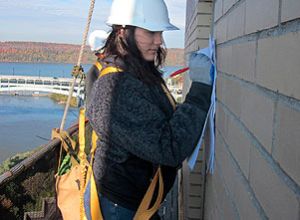 A change in NYC Local Law 11/98 will stagger facade inspections over five years.
A change in NYC Local Law 11/98 will stagger facade inspections over five years.
Sometimes, it feels as if every block in Manhattan has a building covered with scaffolding. A newcomer to New York might well wonder what is going on here. Often, there is very little going on above the sidewalk sheds erected by co-op boards or building owners to comply with the city's facade inspection law. Building boards and owners have long complained that the law made it difficult for them to do the necessary work in a timely and affordable way. The sheds would go up and stay up.
Now, building owners—including co-ops and condominiums—have finally gotten the change in the law they had been seeking: a more realistic timetable for conducting inspections and filing reports. This should make it easier and less expensive to hire contractors to fix problems that are found.
New Staggered Inspections
In July, after intensive lobbying by the Council of New York Cooperatives and Condominiums and by Stephen Varone, president of Rand Engineering & Architecture in Manhattan, City Councilman Daniel R. Garodnick shepherded through a law that will stagger inspections over a period of five years.
That is in contrast with the current version, known as Local Law 11. It requires every building affected by the law—about 12,000 in all—to inspect any wall taller than six stories and file a report listing any defects by the end of the second year of the five-year inspection cycle. Defects in the Unsafe category are supposed to be repaired within 30 days, unless the Buildings Department grants an extension, which typically requires that the sidewalk shed must remain in place until the repair is completed.
Building owners finally have a more realistic timetable for conducting inspections and filing reports.
The current cycle runs from Feb. 21, 2005, to Feb. 21, 2010, which means that reports had to be filed by last February. Human nature being what it is, many buildings, if not most, put things off to the last possible moment. This set off a scramble for engineers, architects, contractors and sidewalk sheds.
The new law is expected to rectify the situation. "They've finally come to their senses," said Anne M. Fried, a board member and the chairwoman of the building committee at 110-118 Riverside Drive, a 16-story, 165-apartment co-op at 83rd Street.
"Every building was competing for the same contractors," she said. "And the more calls the contractors got, the more expensive the bids would be."
To make matters worse, Mr. Varone said, more buildings had more repairs to make. He explained that before Local Law 11 went into effect in 1998, a relatively minor problem like a hairline crack in the brickwork could be listed in an inspection category called Precautionary. Such defects did not have to be repaired immediately and could be carried over on the next cycle's report in the same category.
Under Local Law 11, a minor defect like that hairline crack has to be listed in a category called Safe With a Repair and Maintenance Program, known by the acronym Swarmp (pronounced the way you would expect).
Can't Carry Over Swarmp Items
Swarmp defects cannot be carried over to subsequent inspection cycles. So, in the latest inspections, Swarmp defects from the 2000-to-2005 cycle that had not been addressed—including former Precautionary items that had been carried over for years—had to be listed as Unsafe and repaired immediately.
"That created the perfect storm," Mr. Varone said. "Our office has filed hundreds of Unsafe reports, and the Department of Buildings has gotten thousands of them. And now everyone is killing themselves to meet the deadlines for making repairs."
Councilman Garodnick's facade law addresses this problem. It will stagger the inspections in the next five-year cycle, which begins in 2010. Twenty percent of the buildings covered will have to report during the first year, 20 percent the second year, and so on.
The Buildings Department has until Jan. 1, 2009, to establish a method for determining which buildings have to report in a particular year.
"This law will give everyone some breathing room," said Mr. Garodnick, a Democrat who represents District 4, which runs from Stuyvesant Town to the Upper East Side.
From The New York Times, October 21, 2007.
